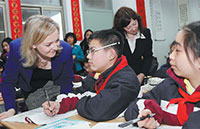Full Text: Progress in China's Human Rights in 2014
(Xinhua) Updated: 2015-06-08 17:00In 2014 the Chinese government promoted development concepts and systems innovation, adopted effective measures to guarantee citizens' access to fair development, had more people to share the fruit of reform and development, and better protected the people's economic, social and cultural rights.
People's living standard further improved. China's GDP in 2014 increased by 7.4 percent over the previous year, and the economy operated within an appropriate range. The economic growth in central and western China was faster than that in the east. As many as 13.22 million new urban jobs were created, more than that in 2013. The total output of grain was 607.1 million tons, an increase of 5.16 million tons over the previous year. The first phase of the central line of the South-to-North Water Diversion Project was completed, providing water from the Yangtze River in the south to 60 million people in the Beijing-Tianjin-Hebei region in the north. More than 66 million rural people began to have access to safe drinking water in that year. In 2014 minimum wage standards were raised in 19 regions. The nationwide annual per capita disposable income reached 20,167 yuan, up 8 percent over the previous year and faster than the economic growth rate in 2014. The annual per capita disposable income for urban residents was 28,844 yuan, and that for rural residents reached 10,489 yuan, up 6.8 percent and 9.2 percent over the previous year, respectively, with the increasing rate for rural residents higher than that for urban residents for the fifth consecutive year. The urban-rural income ratio fell below 3:1 for the first time over the previous 13 years. Nationwide, per capita consumption expenditure reached 14,491 yuan, an increase of 7.5 percent over 2013, among which the consumption expenditure of urban residents was 19,968 yuan and that of rural residents was 8,383 yuan, up 5.8 percent and 10 percent, respectively. By the end of 2014 the number of telephone users in China had reached 1.53 billion, among whom that of mobile phone users reached 1.28 billion, with the penetration rate hitting 94.5 per 100 people. The number of 4G users was 97.284 million, and that of 3G users was 480 million. The number of Internet broadband users surpassed 200 million, among whom that of subscribers using broadband over 4M reached 177 million, taking up 88.1 percent of the total. The total broadband in China was 2500G, the broadband of the international communications gateway reached 9614Gbps, and the broadband of the international communications service gateway reached 3361.9Gbps. The number of trips abroad made by Chinese citizens was 116.59 million, among which those for private purposes reached 110.03 million, an increase of 19.6 percent over the previous year.
Basic public services coverage increase in both urban and rural areas. The State Council issued the National New-Type Urbanization Plan (2014-2020), and the central government appropriated a fund of 1.1 billion yuan to promote the development of new-type professional farmers in two provinces, 14 municipalities and 300 counties. China improved the occupational training and testing of farmers in 2014, with more than 400,000 people trained and tested in that year. China also organized training sessions for leaders in practical rural skills, and 12,000 people participated in the training in 2014. Professional training sessions were also held on modern planting and breeding as well as on animal sanitation and epidemic prevention, with more than 70,000 people receiving the training in that year. By issuing the Opinions on Further Promoting Household Registration System Reform, the State Council lifted all restrictions on settlement in incorporated towns (towns with a population of at least 2,500) and small cities, established a uniform household registration system in urban and rural areas together with a residence permit system, established and improved a basic public service supply mechanism linked with residence period, and steadily promoted the complete coverage of basic public services for permanent urban residents.
Educational fairness better guaranteed. China is continuing to increase its input in educational resources, giving preferential treatment to central and western regions and compulsory education in the countryside. In 2014, the education expenditure from the general public services budget of the central government reached 410.19 billion yuan, up 8.2 percent from 2013. The central government allocated one billion yuan from its budget as supporting funds for pre-school education, 13.266 billion yuan for free textbooks for compulsory education courses, and 7.293 billion yuan as cost of living subsidies for boarders in schools offering compulsory education from families with financial difficulties. Nearly 110 million rural students receiving compulsory education benefited from exemption of all tuition and miscellaneous fees as well as free textbooks, first-grade pupils received dictionaries for free, and 12.4 million boarders from poverty-stricken households in central and western China received cost of living subsidies. Since November 2014 the nutrition subsidies covered by national pilot projects for rural students receiving compulsory education have been raised from 600 yuan to 800 yuan per person per year. In the same year, the central government allocated 17.156 billion yuan for nutrition improvement, benefiting 31.84 million students. Secondary vocational education was made free for more than 10 million students, and national grants were provided to nearly 4.88 million senior high school students, 3.15 million secondary vocational school students and 6.6 million college students. The central government also appropriated 31 billion yuan to upgrade schools with poor compulsory education conditions in poverty-stricken areas, with the focus on promoting pre-school education in rural areas, building dormitories for rural teachers in remote and border areas, building senior high schools in counties with a weak educational foundation in regions inhabited by ethnic minorities, and building special education schools in central and western China. The percentage of students receiving nine-year compulsory education remaining in school and the gross enrollment ratio of senior high schools were 92.6 percent and 86.5 percent, respectively. Twenty-eight provinces, autonomous regions and municipalities directly under the central government have started to address the problem of whether or not permitting children of rural migrant workers who received their compulsory education in cities to sit the national college entrance examinations in cities where they are now living. Institutions of higher learning continued to implement the country's Collaborative Admission Plan for Supporting the Central and Western Regions (initiated in 2008) and the Special Admission Plan for Students from Poor Rural Areas (initiated in 2012), expanding the two plans to cover 200,000 and 50,000 people, an increase of 15,000 and 20,000 people, respectively, over the previous year.
Poverty alleviation steadily promoted. China has adopted a strategy of taking targeted measures for poverty alleviation, and declared October 17 as "China Poverty Alleviation Day." Departments of the CPC Central Committee and the central government at various levels, enterprises and public institutions are paired up with and assisting all of the 592 counties that are key targets of the government's development-oriented poverty-reduction work. The central government appropriated 43.3 billion yuan for poverty reduction in 2014, an increase of nearly 10 percent over the previous year, adopted the policy of giving people work in place of relief subsidies, allocated 5.72 billion yuan to support the building of small and medium-sized infrastructure projects for public welfare, such as water conservancy projects, road construction, etc., and earmarked 680 million yuan as remuneration for people in poverty-stricken areas participating in the construction projects. China also resettled 916,900 impoverished people from poverty-stricken areas at a total cost of 5.5 billion yuan. It allocated 154.1 billion yuan out of the vehicle purchase tax to subsidize 14 contiguous poverty-stricken areas, supporting the building and renovation of 31,700 km of expressways and national or provincial highways, building 96,000 km of rural highways and a batch of rural passenger bus stations, and solving the traffic problems of 93 townships, and 10,500 villages. The central government proceeded with the plan of building 138 bridges to replace ropeways in seven provinces and regions, namely, Sichuan, Guizhou, Yunnan, Shaanxi, Gansu, Qinghai and Xinjiang. By the end of 2014 the impoverished population in rural China had decreased to 70.17 million, based on the criterion that the national poverty line has been set at 2,300 yuan per person per year (calculated at 2010 constant prices). This means that there were 12.32 million fewer poverty-stricken people at the end of 2014 than a year earlier.
The legitimate rights and interests of migrant workers effectively protected. By the end of 2014 the total number of migrant workers in China was 273.95 million, an increase of 1.9 percent over 2013. Governments at all levels endeavored to stabilize and increase employment as well as business development for migrant workers, thus effectively guaranteeing their legitimate labor rights and interests. The central government formulated the Plan to Raise the Vocational Skills of Migrant Workers, which improved social security and employment service at the community level for them, and provided funds to build 269 county-level employment and social security service centers, and 961 town and township service stations. It gave full play to the important role of the trade unions and other rights-protection organizations for safeguarding workers' rights, provided various kinds of employment services to more than five million people, and helped one million people sign labor contracts with a duration of over one year. In 2014 various central government departments and a social group jointly issued the Opinions of the Ministry of Human Resources and Social Security, Ministry of Housing and Urban-Rural Development, State Administration of Work Safety and All -China Federation of Trade Unions on Further Improving Work on Work-related Injury Insurance in the Construction Industry, further defining and detailing the relevant policies and measures. In the same year, human resources and social security departments at all levels investigated and handled 263,000 cases concerning wage arrears. People's courts at all levels investigated and settled 219,000 cases relating to the transfer of land-use rights, disputes over rural homestead and wage arrears, and convicted 753 persons for refusing to pay others for the labor rendered. The Provisions of the Supreme People's Court on Several Issues Concerning the Trial of Administrative Cases Concerning Work-Related Injury Insurance was promulgated in the same year to define employers' responsibility in case of work-related injury insurance, and how to deal with cases of work-related injury caused by third parties. The Provisions also made clear the administrative trial procedures relating to labor relations confirmation, and defined such factors as "work-related, time and place of work" in the identification of work-related injuries.
Social insurance coverage widened. The State Council issued the Opinions on Establishing a Unified Basic Pension Insurance System for Non-working Urban and Rural Residents in 2014, establishing a unified basic pension insurance system nationwide, which solved the problem of laborers, especially migrant workers participating in the basic pension insurance system for urban workers or non-working people. A total of 341.24 million people had participated in the basic pension insurance for urban workers by the end of 2014, and 501.07 million people had participated in the basic pension insurance system for non-working people, increases of 19.06 million and 3.57 million, respectively, compared with 2013. At the same time, some 597.74 million people had participated in the basic medical insurance for non-working urban residents and 736.27 million people had participated in the new rural cooperative medical care system. The coverage of the basic medical insurance system for urban and rural residents exceeded 95 percent. In 2014 a total of 170.43 million people participated in the unemployment insurance scheme, an increase of 6.26 million over 2013, and the number of people receiving unemployment insurance allowances reached 2.07 million, making the average amount of 852 yuan per month. A total of 206.39 million people participated in work-related injury insurance in 2014, an increase of 7.22 million people over the previous year, among whom 73.62 million weremigrant workers, an increase of 980,000 people. As many as 170.39 million people participated in maternity insurance, 6.47 million more than in 2013.
Medical security system further improved. The central government has gradually raised the annual government subsidy for the basic medical insurance for rural and non-working urban residents. In 2014 government subsidies for the new rural cooperative medical care system and medical insurance for non-working urban residents reached 320 yuan per person per year, with the individual contribution rising to 90 yuan. Serious illness insurance for urban and rural non-working residents is now available throughout the country, and the reimbursement rate for patients with serious illnesses is 10 percentage points higher than that for the basic medical insurance. The central government appropriated 22.4 billion yuan in 2014 to improve the medical health service system, including the building of 152 disease prevention and control institutions, 257 maternal and children health-care institutions, 24 other professional public health and disease prevention and control institutions, 360 county-level hospitals, 2,645 town and township hospitals, 53 community health service centers, 44,000 village clinics and 18,000 dormitories in town and township hospitals. The government subsidy for the basic public health services rose from 30 yuan per person in 2013 to 35 yuan in 2014, covering 43 items of services in 11 categories, providing more services and benefiting more people. The central government appropriated 15.4 billion yuan as supporting funds for six major public health service projects, including the prevention and control of HIV, tuberculosis and other serious diseases, healthcare for women and children, supervision of food risks, raising public's awareness about health, and personnel training. The central government poured 9.1 billion yuan into implementing the basic pharmaceuticals system at grassroots medical and health institutions, and village clinics. Another 11.8 billion yuan was allocated to promote reform of state-owned hospitals and standardized training of physicians.
Social assistance further improved. China issued the Interim Measures for Social Assistance, and solved the livelihood difficulties of poverty-stricken urban and rural people in accordance with the law, and ensured equal rights, opportunities and treatment for all citizens who sought social assistance. By the end of 2014 there were altogether 18.8 million urban recipients and 52.09 million rural recipients of subsistence allowances, and 5.295 million people enjoying the "five guarantees" (food, clothing, medical care, housing and burial expenses). The average minimum cost of living and subsidy for urban recipients was 411 yuan per person per month and 275 yuan per person per month, up 10.1 percent and 9.1 percent, respectively, over the previous year. For rural recipients these figures were 2,777 yuan per person per year and 125 yuan per person per month, up 14.1 percent and 12.5 percent, respectively, over 2013. The central government allocated 500 million yuan to encourage all provinces, autonomous regions and municipalities directly under the central government as well as cities and prefectures to establish emergency assistance funds for emergency treatment for seriously ill or injured people whose identities are unknown or who are unable to pay the fees. In 2014, 25.4 billion yuan was spent on providing medical aid to 102 million people nationwide. The in-patient aid, out-patient aid and aid for participating in urban medical insurance and the new rural cooperative medical care system respectively reached 1,723 yuan, 144 yuan and 80 yuan per person. From October 1, 2014, pensions and funds to ensure the minimum living standard for disabled soldiers and other people with special needs both increased by 20 percent.
Construction of government-subsidized housing accelerated. China continued to implement the Opinions of the State Council on Accelerating the Rebuilding of Shanty Towns to give priority to central government's financial input in the rebuilding of shanty towns, and the building of infrastructure supportive to government-subsidized housing projects within the central budget. In 2014 funds provided in this regard within the central budget reached 78.7 billion yuan. At the same time, the central government provided 23 billion yuan as part of the funds in the renovation of dilapidated rural houses, and finished renovating the housing of 2.66 million families. Government-subsidized housing is regarded by governments at all levels as a promise they have to fulfill to the people. Throughout the year of 2014, construction began on 7.4 million government-subsidized apartments, and 5.11 million were basically completed, exceeding the goals of the construction of 7 million apartments and completing 4.8 million apartments set at the beginning of the year. From 2008 to 2014 China provided more than 800 billion yuan from the central budget in urban government-subsidized housing. During this period, construction began on 45 million government-subsidized apartments, of which 20.8 million were to be located in shanty towns. By the end of 2014 China had solved housing difficulties for more than 40 million urban households.
Basic cultural rights better protected. China has speeded up the building of a public cultural services system that covers the entire society, and enhanced the rule of law in the culture market. It has changed 11 items from pre-access approval to post-access approval for investment in this market. At the same time the state has increased its input in cultural programs, carried out the digital cultural programs, and built libraries, art galleries, cultural centers and similar projects that are open to the public for free. In 2014 the central budget allocated 14.38 billion yuan for rural public cultural improvements, effectively improved the public cultural services at the grassroots level, and promoted equal access to public cultural services. By the end of 2014 China had 2,008 art performance organizations, 2,760 museums and 3,311 cultural centers. In addition, China had 3,110 public libraries, which received a total of 522.5 million visits in that year, and 4,246 archives with a total of 128.35 million open archival records. Some 2,115 museums and 43,510 public libraries, art galleries and cultural centers instituted free admission. China had 321 million cable TV users (households) and 187 million cable digital TV users. About 98 percent of China's population had access to radio broadcasts, and the figure was 98.6 percent for access to television programs. China has made radio and television services available for every village with more than 20 households, and is working to expand the coverage to every household. The project of providing direct broadcasting satellite services to every household has covered more than 16 million households so far. In 2014 China produced 429 TV series totaling 15,983 episodes, TV cartoon programs totaling 138,496 minutes. It produced 618 feature films, and 140 other films, including popular science films, documentaries, animated cartoons and special-purpose films. The total cinema box office receipts reached 29.6 billion yuan, an increase of 36 percent over the previous year. Thirty-six domestic films each surpassed 100 million yuan in box office receipts. Meanwhile, China carried out a rural film program, projecting at least one film per month in every administrative village. Outdoor mobile film projection is now giving way to projection at permanent indoor venues, and the number of films to be ordered for purchase exceeds 3,000. The rural library project covers all administrative villages, and a long-term mechanism for regular publication updates is taking shape. The building of digital libraries is also accelerating. In 2014 the central government made use of special lottery funds for the building of 3,600 children's cultural centers for rural schools, up by 80 percent over the previous year. During the period of the 12th Five-Year Plan (2011-2015) the central government provided 3.385 billion yuan of special lottery funds to build and encouraged local governments to build more than 25,000 children's cultural centers for rural schools. According to the sixth national sports venue census at the end of 2013, China had more than 1.695 million sports venues, with a total area of 1.99 billion sq m. In 2014 China's cultural attractions and scenic spots received a total of 1.4 billion visitors, generating an income of 250 billion yuan and providing employment for more than one million people.
- Govt encourages people to work 4.5 days a week
- Action to be taken as HIV cases among students rise
- Debate grows over reproductive rights
- Country's first bishop ordained in 3 years
- China builds Tibetan Buddhism academy in Chengdu
- Authorities require reporting of HIV infections at schools
- Typhoon Soudelor kills 14 in East China
- Police crack down on overseas gambling site
- Debate over death penalty for child traffickers goes on
- Beijing to tighten mail security for war anniversary







